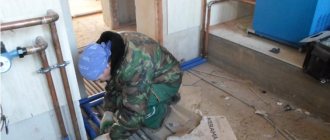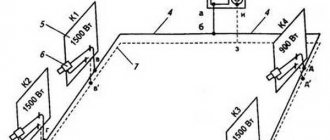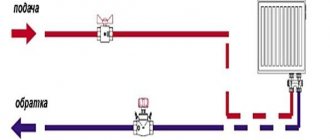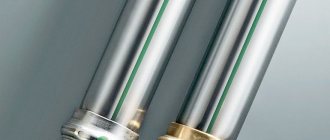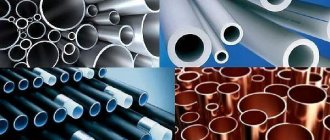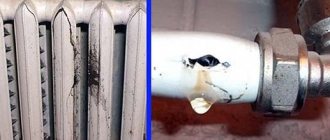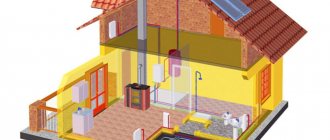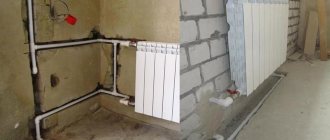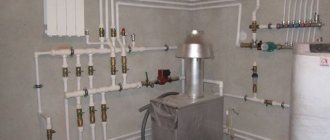Hello friends!
We continue the topic of heating and today I want to talk to you about choosing the diameter of polypropylene pipes that will be used for heating. When designing and installing a heating system, the question always arises: what pipeline diameter to choose.
The choice of diameter, and therefore the throughput of pipes, is important, because you need to ensure the coolant speed is within 0.4 - 0.6 meters per second, which is recommended by experts. In this case, the required amount of energy (amount of coolant) must be supplied to the radiators.
It is known that if the speed is less than 0.2 m/s, then air jams will stagnate. A speed greater than 0.7 m/s should not be done for reasons of energy saving, since the resistance to fluid movement becomes significant (it is directly proportional to the square of the speed), moreover, this is the lower limit for the occurrence of noise in pipelines of small diameters.
What pipes should be used for the heating system?
Polypropylene pipes are divided into several types, which have their own technical characteristics, and they are intended for different conditions. PN25 (PN30) brands are suitable for heating, which can withstand a working pressure of 2.5 atm at a liquid temperature of up to 120 degrees. WITH.
Data on wall thickness are given in the tables.
For heating, polypropylene pipes are now used, which are reinforced with aluminum foil or fiberglass. The reinforcement prevents significant expansion of the material when heated.
Many experts prefer pipes with internal fiberglass reinforcement. Such a pipeline has recently become most widely used in private heating systems.
Selecting the material for the heating riser
Heating from polypropylene
In the vast majority of cases, heating risers in an apartment building are made of steel pipes. After several decades of operation, their condition will be unsatisfactory. If the apartment is replacing pipes with new ones, you must also install a riser made of high-quality materials.
However, this may cause difficulties. The technical characteristics of the new pipe material must meet the requirements. You can learn about them from the technical conditions from the management company, or by consulting with their representatives by phone. Most often they are as follows:
- Correspondence of pipes to the temperature regime of heating operation . Those. the new design must withstand the maximum possible thermal impact without causing emergency situations;
- System pressure . For centralized heating it can range from 3 to 6 atm. But you need to remember that water hammer may occur periodically (when the system is filled). Therefore, a margin of 25-30% must be added to the normalized pressure value. This is why you cannot install a circulation pump on a heating riser;
- Ensuring proper thermal insulation of the pipe . This should only be done if it passes through a non-residential premises where exposure to negative temperatures is possible. For this purpose, thermal insulation of heating risers is done.
Soldering polypropylene pipes
Several classes of pipe materials meet these requirements. The easiest way is to install the same steel one. But most often the choice is made of polypropylene models.
To install a heating riser, it is best to choose a high-strength polypropylene pipe - PN25. It is designed for high maximum pressures. The problem may lie in the heating operating temperature. If the upper limit exceeds +90°C, installation of polypropylene is impossible. Then the only option remains steel pipes.
Under no circumstances should metal-plastic lines be installed. Despite good thermal insulation performance, heating risers made from them will be extremely unreliable. This is due to periodic pressure drops in the system. Gaps most often occur in connecting assemblies, which are made from clamp fittings.
After turning off the heating riser, before starting it for the first time, it is necessary to perform a pressure test. Only after this can coolant be supplied to the circuit.
Questions about selecting the diameter of the heating pipeline
Pipes are produced in standard diameters, from which you need to make a choice. Standard solutions have been developed for selecting pipe diameters for heating a house, based on which in 99% of cases you can make the optimal correct choice of diameter without performing a hydraulic calculation.
Standard outer diameters of polypropylene pipes are 16, 20, 25, 32, 40 mm. The internal diameter of PN25 pipes corresponding to these values is 10.6, 13.2, 16.6, 21.2, 26.6 mm, respectively.
More detailed information on the outer diameters, inner diameters and wall thickness of polypropylene pipes is given in the table.
What is needed for this
To calculate the diameter of the pipe, as a rule, the following factors are taken into account:
- Total heat loss of the home.
- What power do heating radiators have separately in each room.
- The total length of the circuit pipes.
- How is the system wired?
To be able to calculate the diameter of the pipes, it is necessary to determine in advance the total heat loss, the power of the boiler equipment and batteries for each room. It is also important which method will be chosen for pipe routing. Having all these parameters in hand, a future calculation scheme is drawn up.
It is also important to remember some of the specific markings of different pipes. Thus, on polypropylene pipes for heating a private house, the outer diameter is indicated (the same applies to copper products). To calculate the internal parameter, the wall thickness is subtracted from this indicator. Steel and metal-plastic pipes are marked by their internal cross-section.
What diameters should I connect?
We need to ensure the supply of the required thermal power, which will directly depend on the amount of coolant supplied, but the fluid speed must remain within the specified limits of 0.3 - 0.7 m/s
Then the following correspondence of connections arises (for polypropylene pipes the outer diameter is indicated):
- 16 mm - for connecting one or two radiators;
- 20 mm – for connecting one radiator or a small group of radiators (radiators of “regular” power within 1 - 2 kW, maximum connected power - up to 7 kW, number of radiators up to 5 pcs.);
- 25 mm – for connecting a group of radiators (usually up to 8 pieces, power up to 11 kW) of one wing (arm of a dead-end wiring diagram);
- 32 mm – for connecting one floor or an entire house, depending on the thermal power (usually up to 12 radiators, respectively, thermal power up to 19 kW);
- 40 mm - for the main line of one house, if any (20 radiators - up to 30 kW).
Let us consider the choice of pipe diameter in more detail, based on pre-calculated tabular correspondences of energy, speed and diameter.
Boiler and circuit power
In private houses or apartments, heating of the interior is carried out by gas or electric boilers.
The calculation of the required thermal power is carried out depending on the size of the heated area. It is believed that high-quality heating of 1 m2 will require 0.1 m kW of thermal energy. Depending on climatic conditions and gentle operating conditions, this figure increases to 1.3 kW/m2. Factors affecting the power of a heating boiler:
- Type of building material for the enclosing wall structures of a house. The high thermal conductivity of the material in combination with the insufficient thickness of the external walls greatly increases heat losses and then the operation of the boiler with the highest power will be inefficient and unsatisfactory.
- Using a second circuit to heat water. If such an option is provided in advance, a more powerful heat generator is selected.
- Type of fuel. A gas boiler is considered more economical, but it can only be used in areas where there is a gas pipeline.
Water circulation in the system is ensured by a pump designed to optimize the speed of hot water and its return. At the same time, the problem of air pockets squeezed out by a constant flow of coolant is solved.
Views: 255
Selection of pipes by power
The table shows that at a speed of 0.4 m/s, approximately the following amount of heat will be supplied through polypropylene pipes of the following outer diameter:
- 4.1 kW - internal diameter about 13.2 mm (outer diameter 20 mm);
- 6.3 kW - 16.6 mm (25mm);
- 11.5 kW - 21.2 mm (32 mm);
- 17 kW - 26.6 mm (40 mm);
And at a speed of 0.7 m/s, the supplied power values will be approximately 70% greater, which is not difficult to find out from the table.
How much heat do we need?
Marking units
When selecting heating components, the standard unit of measurement is taken into account to determine the value and marking. The basic value that indicates the dimension is defined as a whole number or an inch. It is easy to convert inches into standard millimeters from the ratio: 1 inch equals 25.4 mm.
The size of the pipe is calculated using several indicators - the possible speed of fluid flow and some pressure loss over a one-meter section of the pipeline. Calculating the diameter based on pressure drop is economically feasible and consists of determining the balance sheet value between operating and major maintenance costs.
The larger the diameter, the higher the cost indicators, and in order to pump a certain amount of water where there is a narrowed diameter, much more energy will be required to operate the electric pump.
How much heat should the pipeline supply?
Let's take a closer look at the example of how much heat is usually supplied through pipes, and select the optimal pipeline diameters.
There is a house with an area of 250 sq. m., which is well insulated (as required by the SNiP standard), so it loses heat in the winter by 1 kW per 10 sq. m. To heat the entire house, 25 kW of energy is required (maximum power). For the first floor - 15 kW. For the second floor - 10 kW.
Our heating scheme is two-pipe. One pipe supplies hot coolant, and the other pipe cools it to the boiler. Radiators are connected in parallel between the pipes.
On each floor, the pipes branch into two wings with the same thermal power, for the first floor - 7.5 kW, for the second floor - 5 kW.
So, 25 kW comes from the boiler to the interfloor branch. Therefore, we will need main pipes with an internal diameter of at least 26.6 mm so that the speed does not exceed 0.6 m/s. A 40mm polypropylene pipe is suitable.
From the interfloor branching - along the first floor to the branching on the wings - 15 kW is supplied. Here, according to the table, for a speed of less than 0.6 m/s, a diameter of 21.2 mm is suitable, therefore, we use a pipe with an outer diameter of 32 mm.
7.5 kW goes to the wing of the 1st floor - an internal diameter of 16.6 mm is suitable, - polypropylene with an outer diameter of 25 mm.
For each radiator, the power of which does not exceed 2 kW, you can make an outlet with a pipe with an outer diameter of 16 mm, but since this installation is not technologically advanced, the pipes are not popular; a 20 mm pipe with an inner diameter of 13.2 mm is more often installed.
Accordingly, we use a 32mm pipe on the second floor before branching, a 25mm pipe on the wing, and we also connect the radiators on the second floor with a 20mm pipe.
As you can see, it all comes down to a simple choice among the standard diameters of commercially available pipes. In small home systems, up to a dozen radiators, in dead-end distribution circuits, 25 mm polypropylene pipes are mainly used - “per wing”, 20 mm - “per device”. and 32 mm “to the main line from the boiler”.
Conclusion
Using a not very complex and branched scheme to organize the heating of your home, you can calculate the optimal pipeline diameter on your own. To do this, you need to arm yourself with information about the heat loss of your home and the power of each battery. Next, using special tables and reference books, the optimal value of the pipe cross-section is selected, which can ensure the transportation of the required volume of thermal energy to each of the rooms.
If complex schemes with many elements are used, then it is advisable to invite a professional plumber to calculate them. If you have confidence in your own abilities, it is still recommended to consult with a specialist. There are cases when, due to mistakes made, it is necessary to undertake an expensive reconstruction of the entire circuit.
Features of choosing other equipment
Pipe diameters can also be selected according to the conditions of hydraulic resistance for atypically long pipeline lengths, at which the technical characteristics of the pumps may be exceeded.
But this can happen for production workshops, but practically never occurs in private construction.
For a house up to 150 sq. m., according to the conditions of the hydraulic resistance of the heating and radiator system, a pump of type 25 - 40 (pressure 0.4 atm) is always suitable; it can also be suitable up to 250 sq. m. in some cases, and for houses up to 300 sq. m. . – 25 – 60 (pressure up to 0.6 atm).
The pipeline is designed for maximum capacity. But the system, if it ever operates in this mode, will not last for a long time. When designing a heating pipeline, you can take parameters such that at maximum load, the coolant speed is 0.7 m/s.
In practice, the speed of water in heating pipes is set by a pump that has 3 rotor speeds.
In addition, the supplied power is regulated by the temperature of the coolant and the duration of operation of the system, and in each room it can be adjusted by disconnecting the radiator from the system using a thermal head with a push valve.
Thus, with the diameter of the pipeline we ensure that the speed is within the range of up to 0.7 m at maximum power, but the system will generally operate with a lower fluid speed.
Source: teplodom1.ru/radiattopl/114-kakoy-diametr-trub-iz-polipropilena-dlya-otopleniya.html
Video
Watch the video that shows which pipes to choose for your heating system.
Evgeniy Afanasyev chief editor
Author of publication 10/18/2018
Did you like the article? Save so you don't lose!
Steel pipes for the heating system, despite the emergence and widespread use of pipes made from various polymer materials, remain no less popular than those made from plastic.
The popularity of steel pipes remains due to its strength characteristics; it is not afraid of frost or fire, it cannot be bent or broken simply by leaning on it. Plastic pipes and solder joints on copper pipelines can melt in a fire; if they freeze, they should be warmed with hot air and under no circumstances should you hit them with a hammer. Steel pipes for the heating system endure this abuse quite easily, and they do not notice accidental touches at all.
Moreover, it is still prohibited in preschool and educational institutions to use plastic pipes for laying heating systems due to their fragility and the high probability of damage with the ensuing consequences. And in high-rise buildings where a riser heating system is used, the risers must be made only of steel pipes; plastic ones can only be used for connecting to heating and sanitary appliances.
Steel pipes for heating systems are made from mild carbon steel. The choice of such a material is not accidental, since steel has both high strength and ductility, allowing it to be bent, cut and perform other operations that facilitate the installation of the heating system.
Steel pipes for the heating system have high thermal conductivity - 74 W/m x K, which is a good quality for pipelines carrying heated water. On the contrary, in conditions of transporting cold water, the high thermal conductivity of steel is a disadvantage, since steel pipes “sweat”, become covered with rust on the outside and become wet, as a result of which the building structures adjacent to the pipes are destroyed. In order to avoid destruction of walls, it is recommended to put special insulating tubes made of foamed polyethylene or rubber on steel pipes. In addition to high thermal conductivity, steel has a low temperature coefficient of linear expansion, corresponding to the temperature coefficient of expansion of concrete, which is an important factor when embedding steel pipes in concrete.
The main disadvantage of steel pipes is their low resistance to corrosion. Rust not only slowly and surely destroys steel pipes, but also has a negative impact on water quality and clogs the internal cavity of the pipes, reducing their throughput and impairing the performance of shut-off and control valves. To slow down corrosion, a zinc coating is used, which, however, does not completely prevent the formation of rust.
Steel pipes for heating systems have a service life of approximately 30 - 40 years. At the end of this period, the steel pipeline has to be replaced almost entirely, since during repairs the old pipes literally fall apart in your hands. The second disadvantage of steel pipes for heating systems is their low throughput compared to copper and plastic pipes of the same diameter. The reason for the insufficient throughput is the rough inner surface of the steel pipes, which increases the resistance to the movement of the coolant. It is clear that over time, the throughput of steel pipes becomes less and less, as corrosion products and other deposits settle on their inner walls.
Required data for calculation
The main task of heating pipes is to deliver heat to the heated elements (radiators) with minimal losses. We will build on this when choosing the correct pipe diameter for heating a house. But to calculate everything correctly, you need to know:
- pipe length;
- heat loss in the building;
- element power;
- what kind of pipe layout will be (natural, forced, single-pipe or two-pipe circulation).
The next point, after you have all the above data in your hands, will be necessary to sketch out a general diagram: how, what and where it will be located, what thermal load each heating element will carry.
Then you can begin to calculate the required cross-section of the diameter of the pipe for heating the house. You should also be careful when purchasing:
- metal-plastic and steel pipes are marked by the size of the internal diameter, there are no problems here;
- but polypropylene and copper - by outer diameter. Therefore, we need to either measure the internal diameter ourselves using a caliper, or subtract the wall thickness from the external diameter of the pipe for heating the house.
Don’t forget about this, because we need exactly the “inner diameter of the pipe for heating the house” in order to calculate everything correctly.
Total information
Today there are several options for heating systems, but water heating has been the most popular method for decades.
The option in which forced circulation of the coolant occurs is considered especially effective. When choosing it, you can speak with confidence about the quality of heating of a room even of large footage.
Before designing a heating system, it is worth deciding on the material from which the pipes and components will be made.
Today, steel, polypropylene, metal-plastic and copper products are widely used.
A correctly calculated diameter affects the optimal length of the pipeline, the number of possible radiators to connect and the forecast of heat losses during operation.
Choosing the diameter for your heating
Do not expect that you will immediately be able to select the correct pipe diameter for heating your home. The fact is that you can achieve the desired efficiency in different ways.
Now in more detail. What is most important in a proper heating system? The most important thing is uniform heating and delivery of liquid to all heating elements (radiators).
In our case, this process is constantly supported by the pump, thanks to which, over a specific time period, the liquid moves through the system. Therefore, we can only choose from two options:
- buy pipes with a large cross-section and, as a result, a low flow rate of coolant;
- or a pipe with a small cross-section, naturally the pressure and speed of the fluid will increase.
Logically, of course, it is better to choose the second option for the diameter of the pipes for heating the house, and for these reasons:
- when laying pipes externally, they will be less noticeable;
- when laying internally (for example, in a wall or under the floor), the grooves in the concrete will be more accurate and easier to chisel;
- the smaller the diameter of the product, the cheaper it is, naturally, which is also important;
- with a smaller pipe cross-section, the total volume of coolant also decreases, thanks to which we save fuel (electricity) and reduce the inertia of the entire system.
And working with a thin pipe is much easier and simpler than with a thick one.
Rules for connecting radiators to the riser
Methods for connecting a radiator to a riser
Replacing a riser is most often associated with a general modernization of the heating system. At the same time, not only new pipes are installed, but also radiators and batteries. It is important to choose the right scheme for connecting them to the heat supply system.
First, you need to equip the radiator so that it can effectively perform its functions. Its harness should include the following components:
- Shut-off valves . With its help, you can completely limit the flow of coolant into the battery for its repair or replacement;
- Thermostat . Necessary to reduce heat flow in order to reduce surface temperature;
- Mayevsky crane . Device for removing air pockets.
In addition to possible thermal insulation of heating risers, the layout of the supply lines is taken into account. For a one-pipe system, a bypass must be installed. This is a piece of pipe connecting the inlet and outlet pipes of the radiator. The diameter of the bypass should be one size smaller than that of the heating riser. In this case, the occurrence of a low pressure zone in the system can be avoided.
Experts recommend using identical pipes to connect the drain to the battery. This is necessary to normalize the operating parameters of the entire system, and will also significantly facilitate the complexity of installation. As an additional measure, pressure and temperature sensors can be installed. In this way, you can control the quality of the heating service.
To prevent premature battery clogging, it is recommended to install a strainer. It is mounted on the supply pipe in front of the thermostat.
Formula for calculating the diameter of a pipe for heating a house
For example, let’s select a cross-section for a copper pipe in direct proportion to how powerful the radiators are.
All pipes are manufactured in accordance with GOST. Consequently, all diameters are known in advance, as well as the volume of useful heat that they can pass through themselves, depending on the cross-section and pressure.
Therefore, there is no need to calculate every time what has already been calculated and recorded in special tables. All you need to do is simply find a table with data that suits you and use it to select the diameter of the pipe for heating your home.
How were such tables created? Yes, very simple. Take this formula for calculating the diameter of the pipe, count, and write down the result, and so on for all sections:
D= √(354*(0.86*Q/∆t)/V)
Wherein:
V – fluid velocity in the pipe (m/s); Q – required amount of heat for heating (kW); ∆t — difference between reverse and forward feed (C); D – pipe diameter (mm).
You can try to calculate everything yourself.
It is known that in individual heating systems the coolant moves at a speed of 0.2-1.5 m/s. It is also known that the ideal speed should be in the range of 0.3-0.7 m/s.
If the speed is greater than the optimal values, then the noise increases, and if it is less, then air jams may appear. There are ready-made tables for this. In them we choose the speed that suits us.
There are tables for copper, polypropylene, metal and metal-plastic pipes. They have ready-made solutions for operating at medium and high temperatures. For clarity, let's look at specific examples.
Mounting sleeves
Installation of the heating system is impossible without the use of mounting sleeves. When laying a pipeline through walls and ceilings, the walls of the products come into contact with an aggressive environment.
Due to physical laws, pipes during operation will undergo periodic contraction and expansion. This will lead to mechanical stress on the surface, guaranteeing faster wear at the contact points. To avoid this, SNIP building codes provide for the supply of pipelines with additional structural parts called sleeves.
- prevent the leakage of liquids from adjacent rooms or the street;
- prevent the passage of unnecessary gaseous substances;
- maintain sound insulation;
- ensure the integrity of the structure when dismantling or replacing the pipeline;
- prevent unwanted insects from entering the premises.
The pipeline can pass through any building in two planes: vertical (floors, floors, ceilings) and horizontal (internal and external walls, ceilings).
The sleeve consists of:
- Covers (standard or cut from steel or polymer pipes).
- Packings (filling the cavity between the pipeline and the cover), which can be a soft, non-combustible material. It is possible to use special cement or clay mixtures.
The size of the sleeve assembly is determined by the outer diameter of the pipeline and the thickness of the wall or ceiling: the size of the sleeve and the length of the product should be 10–20 mm larger.
This video will briefly introduce you to the installation of a heating system in an apartment.
General information about heating pipes
All pipes for heating systems can be divided into two types: metal and polymer.
- copper;
- metal-plastic;
- bronze;
- metal corrugated;
- steel.
Copper pipes are superior to all others in the following parameters: long service life, smoothness, which increases the speed of coolant movement, and resistance to ultraviolet radiation.
- polyvinyl chloride (PVC);
- polyethylene terephthalate (PET);
- metal-plastic;
- polyurethane;
- propylene;
- polypropylene.
The cross-sectional diameter in which propylene and polypropylene pipes are offered can be in the range of 16-110 mm. The advantages of this material include: relatively low weight, ease of processing and installation work, low price.
Calculation of diameter for a two-pipe heating system
We will calculate using the example of a simple two-story house. On each floor we have two wings. The house itself will have a two-pipe heating system with the following parameters:
- total heat loss – 36 kW;
- loss on the 1st floor – 20 kW;
- loss on the 2nd – 16 kW;
- polypropylene pipes were installed;
- system operation in 80/60 mode;
- temperature – 20 C.
Below is table (a) based on the data from which we will determine the required pipe diameter. In the table, cells with the best (optimal) fluid velocity are marked in green.
Let's count. Through the section of pipe that connects the first fork and the boiler, the entire volume of liquid passes through, therefore, all the heat, and this is 38 kW. Let's determine which pipe we need to take here.
We take our table, look for the corresponding line in it, then go through the green cells and look up. What do we see? And we see that with such parameters two options suit us: 50 and 40 mm. Naturally (this was written about above), we choose a smaller diameter of the pipe for heating the house, 40 mm.
Next we look at the fork, which divides the coolant movement into the second and first floors (16 and 20 kW). Again we look at the values from the table and find that in both directions a pipe diameter of 32 mm is needed.
We have two wings on each floor. The circuit is also divided into two branches. We count the first floor:
20 kW / 2 = 10 kW per wing
Second floor by analogy:
16 kW / 2 = 8 kW per wing
Again, we take our table and determine that in these areas we need a pipe with a cross-section of 25 mm. It is also clearly seen from the table that we will use this diameter until the load drops to 5 kW, then we will use 20 mm pipes.
Important! From personal experience I can say that it is better to switch to a pipe diameter of 20 mm when the heat load is not 5 kW, but 3 kW.
In this simple way, we calculated all the pipe diameters for heating the house of the polypropylene pipes we needed for a two-pipe heating system.
For the reverse supply of water, you do not need to calculate anything, everything is much simpler: you do all the wiring with pipes of the same diameter as for the direct supply. As you can see, there is nothing complicated. All you need is a good table suitable for a specific case.
Some nuances of calculating the diameter for metal pipes
If you decide that you will use metal pipes for the heating system, then you need to take into account that they lose heat. In small areas, it is practically unnoticeable.
But on extended systems, it may happen that the very last heating elements in the chain will be cold or slightly warm. This is also a consequence of incorrect choice of pipe diameter. Fortunately, heat loss can be easily calculated:
q = k * 3.14 * (tv-tp) q - heat loss per 1 meter (W/s); k – heat transfer coefficient (W * m/s); tв - temperature of hot supplied water (C); tп — ambient temperature (C).
Let's take a pipe with a diameter of 40 mm. Let's say the wall is 1.4 mm thick. Material – steel. Let's calculate:
q = 0.272 * 3.15 * ( 80 – 22 ) = 49 W/s
Here is another proof of why you need to take a pipe diameter for heating a house with a smaller diameter. After all, it is clear that the thicker the pipe, the much more heat we will lose.
And in this example, we received losses of almost 50 W per 1 meter of distance. And if the system is quite extended, then all the heat can be lost.
But don't be upset! Such accurate calculations are needed only for multi-storey residential buildings. For individual heating systems, everything is simpler: calculations are rounded up and this gives a certain margin.
Such different diameters
Due to the difference in the naming system for pipes made from different materials, some confusion inevitably arises in the mind of a potential buyer. I will try to clarify this issue.
- The steel pipe is marked with a conditional bore, or DN. It is approximately equal to the internal diameter; small deviations of the actual size from the DU are due to the variation in the wall thickness of ordinary, light and reinforced water and gas pipes;
The nominal bore of a steel pipe is approximately equal to its internal diameter.
- The DN marking indicates the same DN (conditional bore). However, DN is often specified in inches. An inch is 2.54 centimeters; only markings in inches are traditionally rounded to several whole and fractional values, which aggravates the confusion. For the convenience of the reader, I will provide a table of correspondence between the sizes of steel pipes in millimeters and inches;
| DU | Size in inches |
| 15 | 1/2 |
| 20 | 3/4 |
| 25 | 1 |
| 32 | 1 1/4 |
| 40 | 1 1/2 |
| 50 | 2 |
- Pipes made of cross-linked and ordinary polyethylene, polypropylene and metal-polymer products are marked with an outer diameter . On average, their diameter is one step larger than the internal section: a pipe measuring 25 mm has the same internal cross-section as a steel pipe DN 20, 32 mm corresponds to DN 25, and so on;
Internal and external dimensions of polypropylene pipes. Different operating pressures determine the variation in wall thickness.
- All polymer products have lower hydraulic resistance than steel due to minimal wall roughness. In addition, they do not become overgrown with rust and lime deposits over time, so their diameter is selected without reserve. But it is better to buy steel pipes for a central heating system taking these factors into account, rounding the calculated pipe diameter up.
An exposed steel line in the central heating system of an apartment building.
Where can I get the tables?
Everything is simple here. Usually, all detailed tables with all the necessary data can be viewed (or downloaded) on the websites of pipe manufacturers. But it happens that there are still no tables.
You can get out of this situation as follows. If there are no tables for the outer diameter, then take the one for the inner diameter and calculate according to it. Yes, there will be inaccuracies, but, as experience shows, for forced circulation they are completely insignificant and acceptable.
Having analyzed a huge number of already installed and perfectly working systems, experts noticed a certain pattern in the choice of pipe cross-section. It is mainly suitable for small-sized autonomous systems.
In private houses, the pipes that come out of the boiler are most often one-half and three-quarters in size. This diameter of the pipe for heating a house is used until the first fork, and at each subsequent fork the cross-section is reduced by exactly one step.
But this method is applicable only for apartments and one-story houses; for high-rise buildings, alas, everything will have to be calculated very carefully.
If we have a private house or apartment, autonomous heating for no more than 5-8 radiators and 2-3 forks, we can easily calculate everything ourselves. We need to know how powerful each heating point is, the heat loss in the room and a good table for selecting the pipe diameter.
However, as has already become clear, trust experienced specialists to calculate a complex multi-level system with numerous junctions and forks. Well, if you still decide to do everything yourself, then at least read articles like ours and consult with experts.
Source: eurosantehnik.ru/kak-vybrat-diametr-truby-dlya-otopleniya-doma.html
Types of pipes
The selection of the diameter of the heating pipe depends on the material from which the elements are made. The parameters affect not only the cross-sectional dimensions, but also the installation method, the cost of the project and possible heat loss. For heating systems, 4 popular types are used.
Steel
Metal pipes when creating utility networks are an inexpensive and practical option, which have high thermal conductivity and a maximum pressure of up to 30 atmospheres. With proper use, the structures will last 20-30 years. The raw material has no temperature restrictions, so it is often used in a steam system at 100-130 C.
Due to cost and resistance to expansion, property owners often choose carbon steel. Corrosion is the main disadvantage of metal models. During oxidative processes, roughness appears on the surface of the walls, on which deposits accumulate. As plaque grows, the passage for water decreases and the thermal conductivity of the product decreases. When the walls become thinner due to rust, breakouts form. The problem can be minimized by using high-quality coolant in the system and regular flushing of pipes.
Carbon models Source x-teplo.ru
Galvanized steel is a little less capricious. The coating protects the metal from corrosion, thereby increasing the service life of the utility network. The models can withstand loads during water hammer and function perfectly in high temperature conditions.
Stainless steel pipes are superior in durability to galvanized and carbon types. A properly installed structure is inert to aggressive coolant, therefore it is not afraid of corrosion and will last more than 30 years. Elements made by seamless welding are suitable for the heating circuit.
Stainless steel options Source ovknn.ru
The disadvantage of all steel pipes is the weight and complexity of installation. Structures do not bend without special equipment, so at bends it is necessary to use additional parts that reduce the efficiency of the utility network. Now there are options in the form of corrugation, but they are also unstable to the aggressive environment of coolants.
Copper
The maximum operating temperature is 200-250 C, pressure is more than 30 atmospheres. If installed correctly, the heating system will last 90-100 years. The metal has high resistance to corrosion and freezing. According to production technology, copper pipes are divided into 2 types:
- Unannealed. Very strong material will not crack under pressure up to 40 atmospheres.
- Annealed. After heat treatment (annealing), the products become elastic and flexible, while their strength decreases.
Compared to steel, copper has a high density, so the pipes have thin walls and are light in weight. Due to good thermal conductivity, the circuit heats up quickly and evenly. Thanks to the flat surface, the circulating fluid has minimal resistance. There are no growths on the internal partitions, which eliminates the appearance of blockages and a decrease in efficiency.
Heating solution made of metal Source otoplenie-doma.in.ua
Copper pipes are not compatible with other metals. Upon contact with steel, aluminum or cast iron, chemical processes begin in the liquid and gas is formed. The utility network must provide bleed valves for accumulations. Additional parts should be made of copper or brass, radiators should be made of stainless steel.
In a heating system with copper pipes, a well-purified coolant is used. Solid debris can damage soft metal. Additionally, a mechanical cleaning filter is included in the network. The material has high electrical conductivity, so the circuit must be grounded.
Metal structures for a cottage Source kenoll.ru
Polymer
The maximum temperature of the coolant varies between 90-95 C. The structure will withstand 130 C for a short time, but with prolonged contact the polymer pipes are deformed. If the operating rules are followed, they will last up to 30 years. When connected to heating, the circuit is resistant to pressure surges.
Due to the plasticity of the material, pipes are easy to lay without cutting and without additional connections. For welding, a special apparatus is used that heats the parts. The soldering points in the finished structure are not visible to the naked eye.
Plastic models for a private home Source teplomir.in.ua
Plastic is not demanding on the quality of the liquid in the heating system. The raw material does not enter into a chemical reaction, therefore it does not rust or be destroyed by corrosion. Ideally smooth walls do not reduce the speed of the coolant and are not covered with plaque.
Reinforced polymer pipes are used for heating, which can be identified by markings on the surface (PPR-FR-PPR, PPR-GR-PPR). The reinforcing material is fiberglass or aluminum.
Heating solution Source oboiman.ru
How to choose the correct pipe diameter for heating a house - table and calculations
It is not difficult for a professional to calculate the optimal cross-section of the pipeline. Practical experience + special tables - all this is enough to make the right decision. But what about the average home owner?
After all, many people prefer to install the heating circuit on their own, but do not have a specialized engineering education. This article will be a good hint for those who need to decide on the diameter of the pipe for heating a private home.
There are several nuances that you need to pay attention to:
- Firstly, all data obtained based on calculations using formulas are approximate. Various roundings of values, averaged coefficients - all this introduces a number of amendments to the final result.
- Secondly, the specific operation of any heating circuit has its own characteristics, so any calculations provide only indicative data, “for all cases.”
- Thirdly, pipe products are produced in a certain range. The same applies to diameters. The corresponding quantities are located in a certain row, with gradation by value. Therefore, you will have to select a denomination that is closest to the calculated one.
Based on the above, it is advisable to use the practical recommendations of professionals.
All Doo are in “mm”. In brackets - for systems with natural coolant circulation.
- The total line pipe is 20 (25).
- Battery outlets – 15 (20).
- With a single-pipe heating scheme, the diameter is 25 (32).
But these are general parameters of the circuit and do not take into account its specifics. More precise values are shown in the table.
Water supply heating installation services
LLC DESIGN PRESTIGE 8(495)744-67-74
In addition to fast and high-quality repair of heating pipes, we provide professional installation of turnkey heating systems. On our heating page > resant.ru/otoplenie-doma < you can view and get acquainted with examples of our work. But to be more precise, it is better to check with an engineer about the cost of work and equipment.
To contact us, use the contact number of DESIGN PRESTIGE LLC 8(495) 744-67-74 , which you can call around the clock.
What is taken into account when choosing pipe diameter
Heat generator power. It is taken as a basis and determined individually for each building. What does the owner focus on when purchasing a boiler?
For the total area of all heated premises. This is exactly what the manager at the point of sale will definitely clarify if the buyer has questions about this item.
On a note! It is generally accepted that to ensure high-quality heating of a house, it is necessary to adhere to the following ratio - 1 m2 / 0.1 kW. But if we take into account the peculiarities of the climate and the gentle operating mode of the unit (so as not to “drive” it to the limit), then about 30% should be added. It turns out - 1/1.3.
Coolant speed. If it is less than 0.25 m/sec, then there is a risk of airing the system and causing traffic jams on the highway. Exceeding the value of 1.5 is fraught with “noise” in the highway.
This is especially noticeable when the pipes are metal, and even laid in an open way. But in any case, the movement of the coolant along the route will be clearly audible.
Practice has proven that for a private building (with an autonomous heating circuit) you should focus on an indicator in the range from 0.3 to 0.7. This is the optimal value for any system.
Circuit configuration. In private houses, when installing it, as a rule (regardless of the circuit), all the “threads” are connected to the collector. Each of them is “loaded” with a certain number of radiators.
There is no point in purchasing pipes of the same diameter for all lines, given that the larger the cross-section of the workpiece, the higher the price of 1 running meter.
Pipe diameter. The outer one does not play a special role, since products made from different materials have differences in wall thickness. This parameter only indicates the ease of fastening the product. The internal diameter is about the throughput of the route. It is he who is decisive.
On a note! It is customary to operate with the average value of the cross-section (the diameter of the nominal diameter). It is this parameter that is used in the calculations.
Pipe diameters are usually indicated in inches. For us, this is an unusual (non-metric) system, so you should know the rules for converting quantities. The ratio of inches to centimeters is ½.54 (or 25.4 mm). Pipe material – metal-plastic, steel, PP, PE.
Specifics of the structure. First of all, this relates to the effectiveness of its thermal insulation - what materials it is assembled from, what method is used, and so on.
Pipe material for communications. What are the influence of pipe parameters?
Questions about what the water supply system should look like and what diameter of the pipes should be in the pipeline supplying heat to the heating radiators are resolved at the stage of designing life support systems in the house. As a result, the diameter of polypropylene pipes for water supply can often differ from the identical size of the heating system pipeline, since these communications have different purposes and are therefore exposed to different factors.
The throughput of heating networks, recommended by professional specialists, must ensure a coolant movement speed of at least 0.4-0.6 m/s - the amount of thermal energy supplied to heat residential premises depends on this.
Note: if the boiler water supply speed in the heating system pipeline is less than 0.2 m/s, then there is a high probability of airing of the line, and exceeding the supply speed by 0.2 m/s will lead to increased costs - the costs of equipment exposed to high temperatures will increase. loads
The use of polypropylene products has significantly simplified the work of equipping residential buildings with water heating and water supply systems. However, you need to know exactly what type of polymer pipe material is suitable in a particular case. The types of polypropylene pipes that exist today have different technical characteristics and are designed for a specific area of use.
The most reliable products for installing water heating pipelines and hot water supply systems (DHW) are PN25 or PN30 products. It is these brands that can withstand pressures of up to 25 and 30 atm. respectively, at an operating coolant temperature of 950C. Even short-term operation of such pipes is allowed at a water temperature of 1200C, since the distinctive feature of these products is their thick walls.
Samples of polypropylene pipes reinforced with aluminum.
*
Main article about polypropylene pipes.
For cold water supply, polypropylene pipes with a uniform wall are used. Reinforced products are used for hot water supply systems and heating circuits, since the inclusion of an aluminum or fiberglass shell in the wall structure of a polypropylene pipe significantly increases the strength of the pipe material and reduces the amount of thermal expansion.
For reference: in reinforced pipelines the thermal expansion is 0.03 mm/m0C, while for channels with a wall made of homogeneous polypropylene this value is about 0.15 mm/m0C. Based on this, homogeneous products are suitable for cold water supply, and only reinforced polypropylene is used for heating and hot water systems.
